A dam is a human-made structure that is primarily used to hold back water. Dams are constructed for many purposes, including reservoir creation, flood prevention, irrigation, and hydroelectric power. Today, there are almost 50,000 large dams in use worldwide. The United States has the second largest number of dams in the world at 5,500, and China has the most with a whopping 19,000. The United States has 50 major dams – the most in the world. But before we had the Hoover Dam or any of the other major dams of today, our ancestors had to learn about dam engineering, and some of that was done through trial and error.
The World’s First Dam
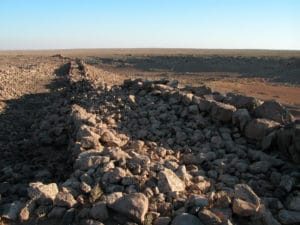 The first known dam to be built is the Jawa Dam, which is actually the largest in a series of dams that are all part of one reservoir system. Located in modern-day Jordan, the Jawa Dam was originally constructed around 3,000 BCE in what was then Mesopotamia. Surprisingly, the Jawa Dam was actually an architectural feat of the times. While most ancient dams were simple gravity dams constructed of gravel and masonry, the Jawa Dam was reinforced with rock fill behind the upstream wall in order to protect the wall from water pressure breach. This safety feature was incredibly innovative for this time period. Unfortunately, the reinforced design was forgotten after the Jawa Dam and was not actually “reinvented” until modern times. The Jawa Dam site is arguably the most important archaeological site in the history of large-scale water projects, and the dam itself was so well designed and constructed that the ancient structure stood until just a few years ago, when it was partially ruined due to physical intervention. In its prime, the Jawa Dam was 15 feet tall, 80 feet long, with a base of 15 feet. It created the Jawa Reservoir that had a capacity of 1.1 million cubic feet.
The first known dam to be built is the Jawa Dam, which is actually the largest in a series of dams that are all part of one reservoir system. Located in modern-day Jordan, the Jawa Dam was originally constructed around 3,000 BCE in what was then Mesopotamia. Surprisingly, the Jawa Dam was actually an architectural feat of the times. While most ancient dams were simple gravity dams constructed of gravel and masonry, the Jawa Dam was reinforced with rock fill behind the upstream wall in order to protect the wall from water pressure breach. This safety feature was incredibly innovative for this time period. Unfortunately, the reinforced design was forgotten after the Jawa Dam and was not actually “reinvented” until modern times. The Jawa Dam site is arguably the most important archaeological site in the history of large-scale water projects, and the dam itself was so well designed and constructed that the ancient structure stood until just a few years ago, when it was partially ruined due to physical intervention. In its prime, the Jawa Dam was 15 feet tall, 80 feet long, with a base of 15 feet. It created the Jawa Reservoir that had a capacity of 1.1 million cubic feet.
Ancient Dams
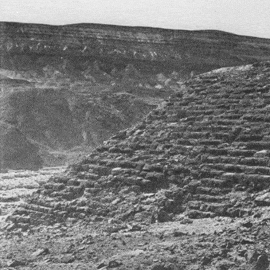
Subsequent ancient dams were built by several cultures with varying rates of success. Approximately 400 years after the construction of the highly successful Jawa Dam, Egyptians built the Sadd el-Kafara, or Dam of the Pagans, most likely to supply water to the local quarries outside of Cairo rather than for irrigation, since the flooding Nile would have supplied plenty of water to the farmers. After ten years of construction, the masonry dam was 37 feet tall, 348 feet long, with a base of 265 feet, contained over 100,000 tons of gravel and stone, and had a limestone cover to resist erosion. Unfortunately, as it was nearing completion, it failed. Due to poor design and lack of a spillway, the dam washed away during a heavy rainfall and was never repaired or completed. Discouraged by the failure of this massive project, ancient Egyptians were dissuaded from constructing other dams until many years later.
The Romans, highly regarded for their advances in hydraulic engineering, were prolific in dam construction during the height of the empire. In addition to the vast network of aqueducts, the Romans built a plethora of gravity dams, most notably the Subiaco Dams, which were constructed around 60 AD to create a pleasure lake for Emperor Nero. The Subiaco Dams were a series of three gravity dams on the Aniene River in Subiaco, Italy, the largest of which stood 165 feet tall and held the honor of being the tallest dam in the world until its destruction in 1305, historically attributed to two careless monks. The Romans also constructed the world’s first arch dam in the Roman province of Gallia Narbonensis, now modern-day southwest France, in the 1st century BCE. The remains of the Glanum Dam, the first recorded true arch dam in history, were discovered in 1763. Unfortunately, a modern arched gravity dam replaced the ancient structure in 1891, and all remnants of the Glanum Dam were lost. The Romans were also responsible for constructing the world’s first buttress dams, although they tended to fail due to their too-thin construction. One third of all dams on the Iberian Peninsula were buttress dams.
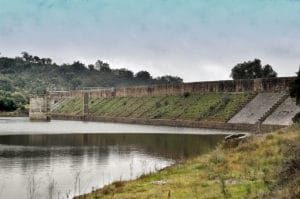
Asian cultures also contributed to dam engineering. As early as 400 BCE, Asians built earthen embankments dams to store water for the cities of Ceylon, or modern-day Sri Lanka. In the 5th century AD, the Sinhalese built several dams to form reservoirs to catch the monsoon rains for their intricate irrigation system, and many of these reservoirs are still in use today. Around the 12th century AD, about 4,000 dams were built by an egotistical Sinhalese ruler, King Parakrama Babu. While these structures were gargantuan for the time, such as one dam that stretched for almost nine miles, they are not considered to have any true engineering significance, as they did not supply water to the villages. Built to massage the king’s giant ego, these enormous dams were monuments rather than functional structures.
Japan and India also contributed to early dam engineering, with much success. In fact, five of the ten oldest dams still in use are located in these two countries. The oldest operational dam in the world, the Lake Homs Dam in Syria, was built around 1300. The masonry gravity dam is over one mile long, 23 feet high, and creates Lake Homs, which still supplies water to the people of Homs today.
Middle Ages

During the dark ages, dam construction came to a near halt, resuming around the 15th century AD. During this time, no major contributions to dam engineering were made, and the majority of the dams constructed in Europe, where rainfall is plentiful and regular, were modest structures. It wasn’t until the 1850s, when civil engineering professor William John Macquorn Rankine at Glasgow University demonstrated a better understanding of earth stability and structural performance, that dam engineering improved. In fact, Rankine’s work was so innovative, it contributed to the acceptance of civil engineering as a valid university subject and improved the status of civil engineers. Since Rankine, geological, hydrological, and structural scientific contributions have been extensive, and the understanding of dam engineering has improved significantly as a result.
Modern Times
Major advances in concrete dam design were made from 1853 to 1910 by British and French engineers. During this time, understanding of the relationship between the precise weight and profile of gravity dams and the horizontal thrust of water increased extensively. In 1910, further advances were made as engineers began to take a more three dimensional approach to dam engineering, examining the effect of individual stresses and deflections on multiple points rather than on the structure as a whole. By recognizing the complexity of the structure and understanding its interconnectedness, engineers were able to make exponential advances in dam engineering. As a result of this enhanced understanding, model techniques were implemented at this time. Originally built in rubber, plaster, plasticine, or concrete, modelling is now also done digitally, allowing multi-faceted and comprehensive testing and examination of structural stability.
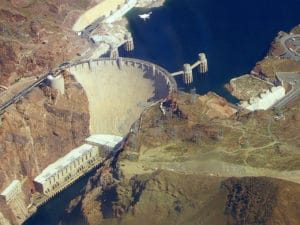
The world’s largest and most complex dams have all been built within the last century, due to engineering as well as technological advances. In addition to supplying water and controlling flooding, modern dams are often constructed to provide hydroelectric power. The Hoover Dam, a concrete arch-gravity dam constructed in the Black Canyon of the Colorado River in 1936, is a prime example of the major advances made in dam engineering. The massive dam, which impounds Lake Mead, stands a whopping 726 feet tall and has a reservoir capacity of 28,537,000 acre feet. It also provides four billion kilowatt-hours of hydroelectric power — enough to supply the private and public electrical needs of over eight million people in Nevada, Arizona, and California— each year. Once the tallest dam in the world, the Hoover Dam lost its title to Switzerland’s 820-foot-tall Mauvoisin Dam in 1957. In the United States, California’s Oroville Dam is now the tallest at 770 feet.
Looking Forward
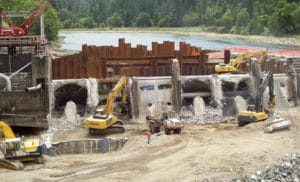
While dams have been being constructed for over 5,000 years, the last 100 years have seen the most significant contributions in dam engineering. With the increased understanding of earth sciences comes the realization that some dams are actually detrimental to the earth’s ecology. Because of this knowledge, over 900 dams in the United States have been removed since 1990. Also, the understanding of dam safety has made significant strides over the last 100 years, and dam safety programs have been implemented in 49 of the 50 US states — only Alabama has no dam safety program. Of those 49 states, all but eight also require that all significant and high hazard dams require Emergency Action Plans (EAPs).
With the tens of thousands of existing large dams throughout the world, and the ever-increasing demand for water and power, dams will continue to make a significant impact on modern day life. And, as is evidenced by history, dam engineering will continue to evolve as additional innovations, discoveries, and technological advances are made.
